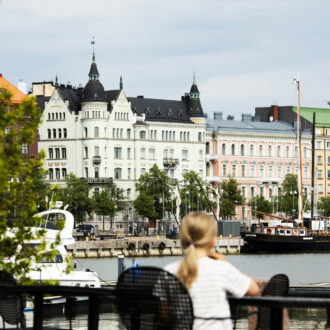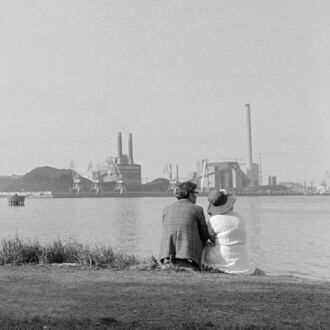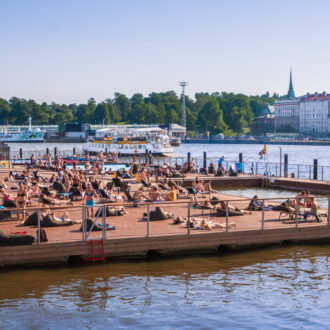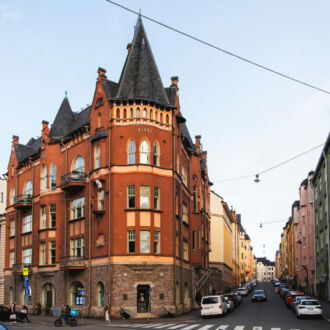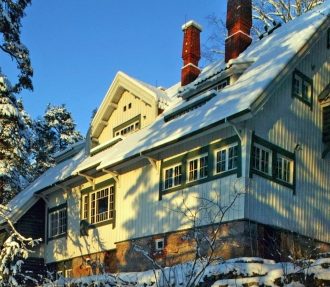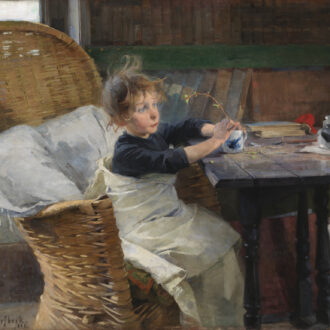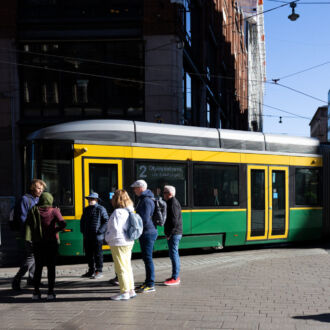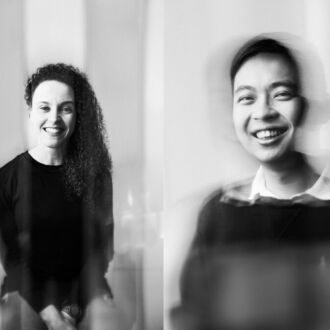Many of the Finnish capital’s photogenic sculptural guardians can be found on art nouveau buildings.
Known locally as Jugend (from Jugendstil (youth style), a German term for art nouveau), the genre bloomed from 1895 to 1915 and includes hundreds of buildings in the Finnish capital. Animals, gargoyles and other figures are also visible across various other architectural styles.
Photographer Kirsi-Marja Savola takes a closer look at some of Helsinki’s most intriguing façade sculptures.
[We list the building name (if any), street address, neighbourhood, architect and year of construction. Click the arrows or swipe to see more pics.]
Mythical creatures and legends
Pohjola Building, Aleksanterinkatu 44, Kluuvi
Herman Gesellius, Armas Lindgren and Eliel Saarinen, 1901
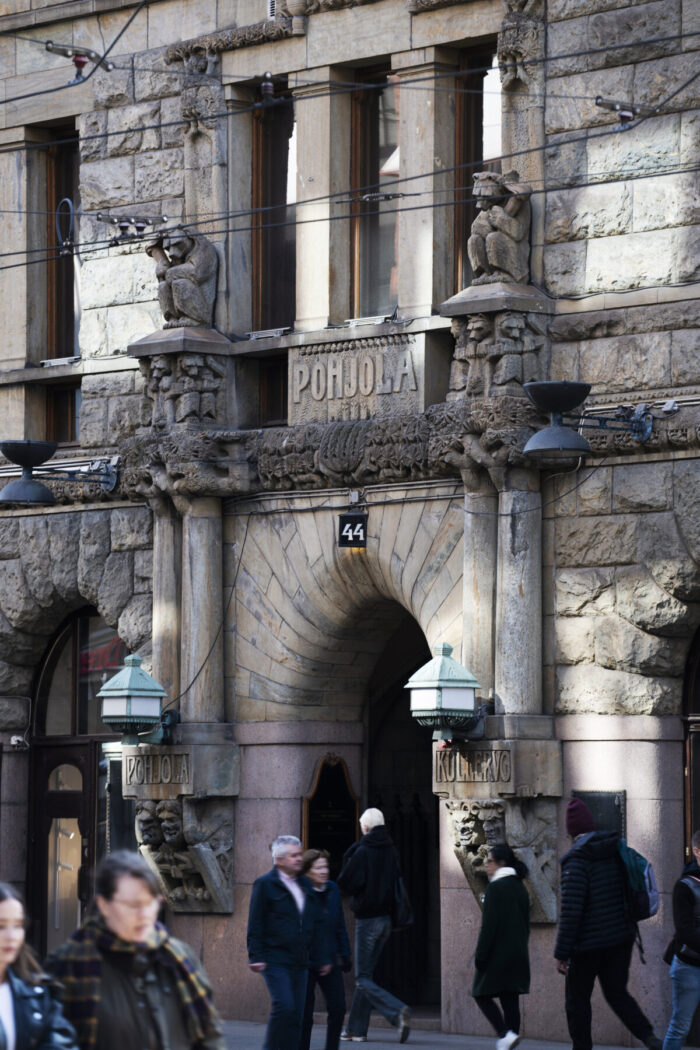
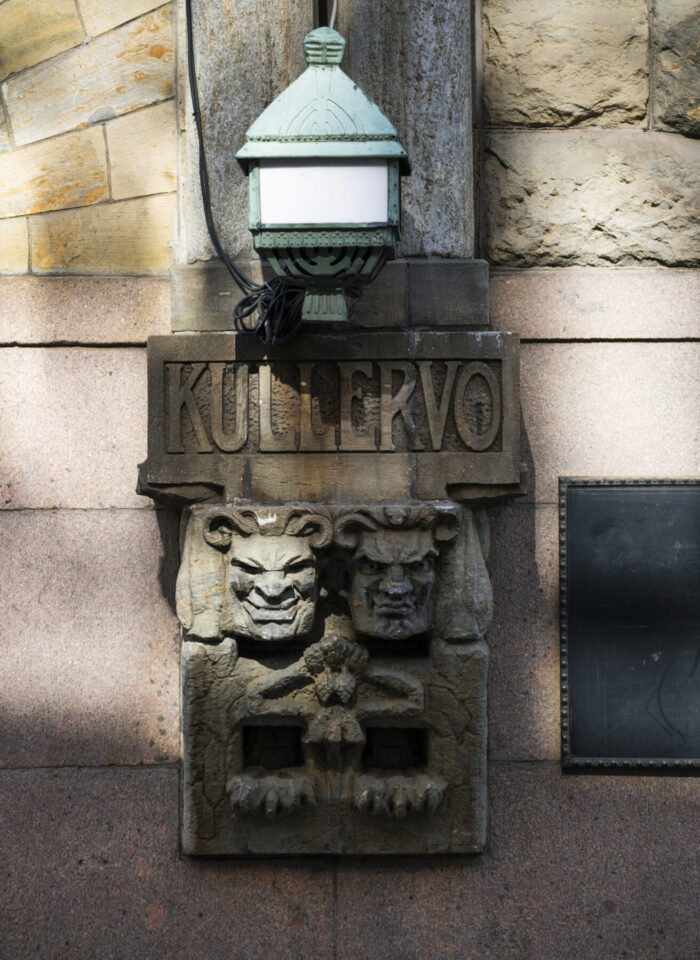
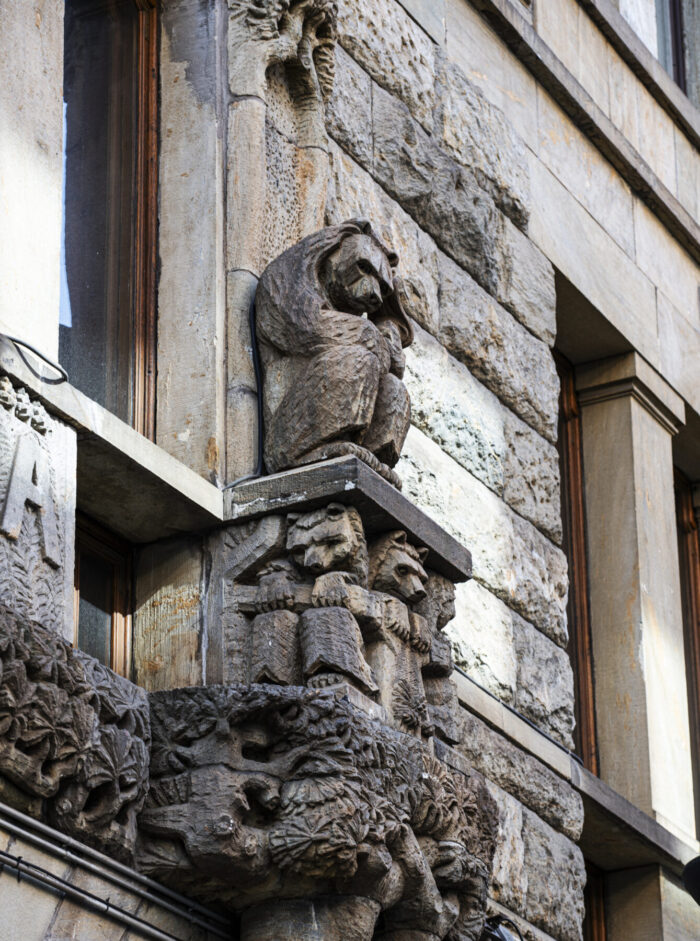
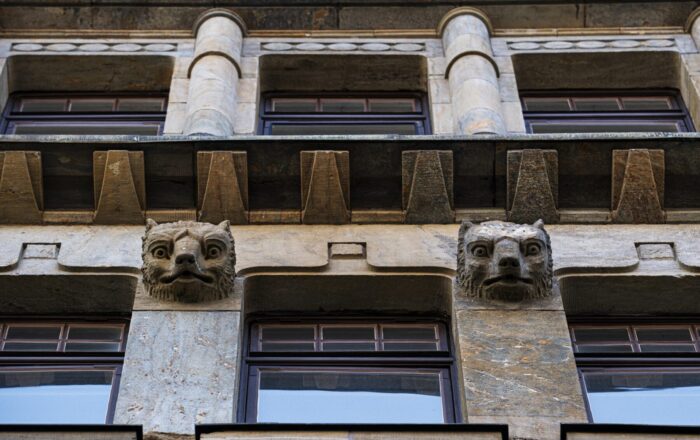
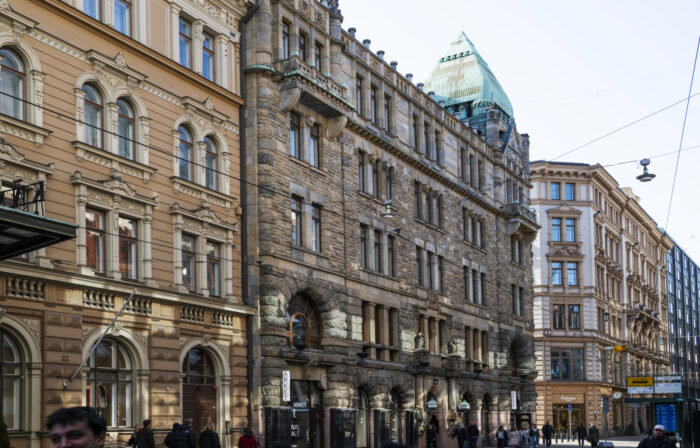
Named after Pohjola, the mythical Northland of Finnish folklore, this building features bears, squirrels, trees and numerous grotesque faces. Many of these carved figures surround the grand entrance, looming over visitors.
Originally commissioned to house two prominent insurance companies, Pohjola and Kullervo, the building cleverly blends mythological imagery with the modern world of risk and protection. The choice of symbols is striking – you could say that ancient representations of misfortune and peril have been repurposed to promote a modern concept: the need for insurance.
Wellamo, Vyökatu 9, Katajanokka
Selim A. Lindqvist, 1904
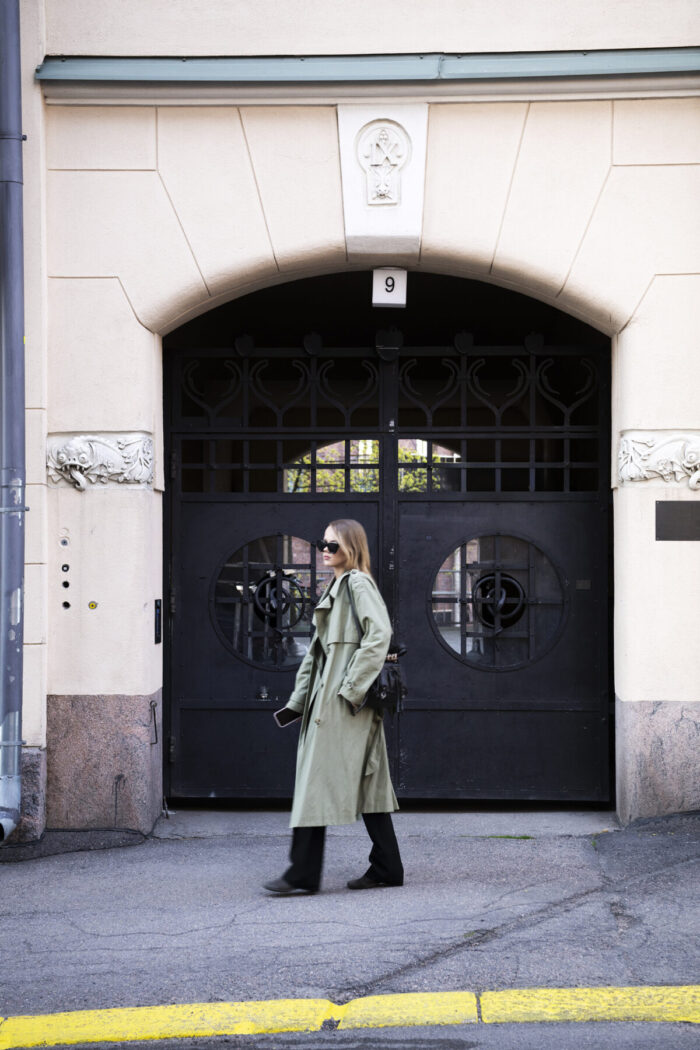
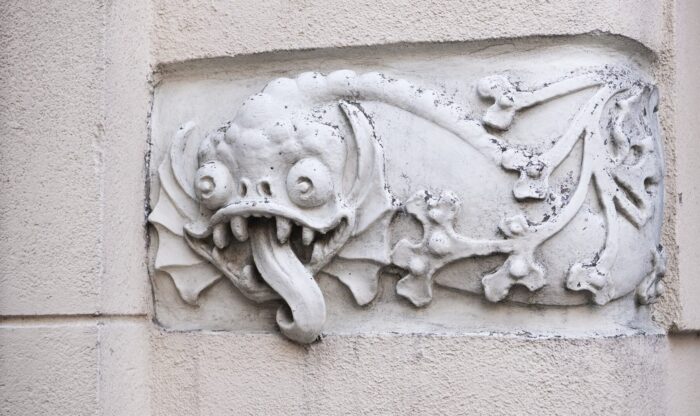
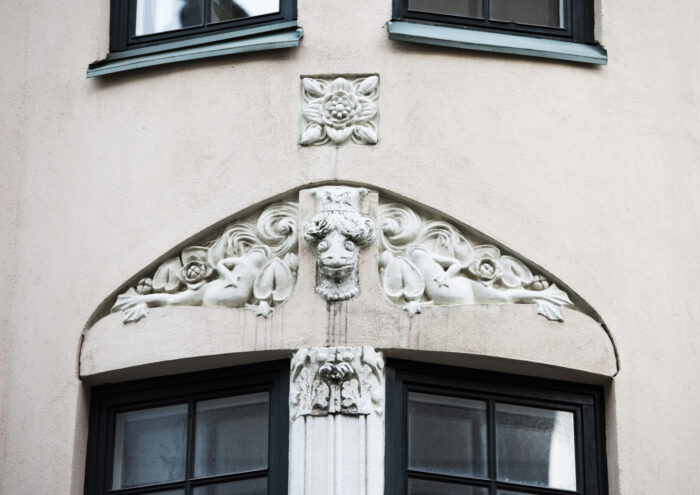
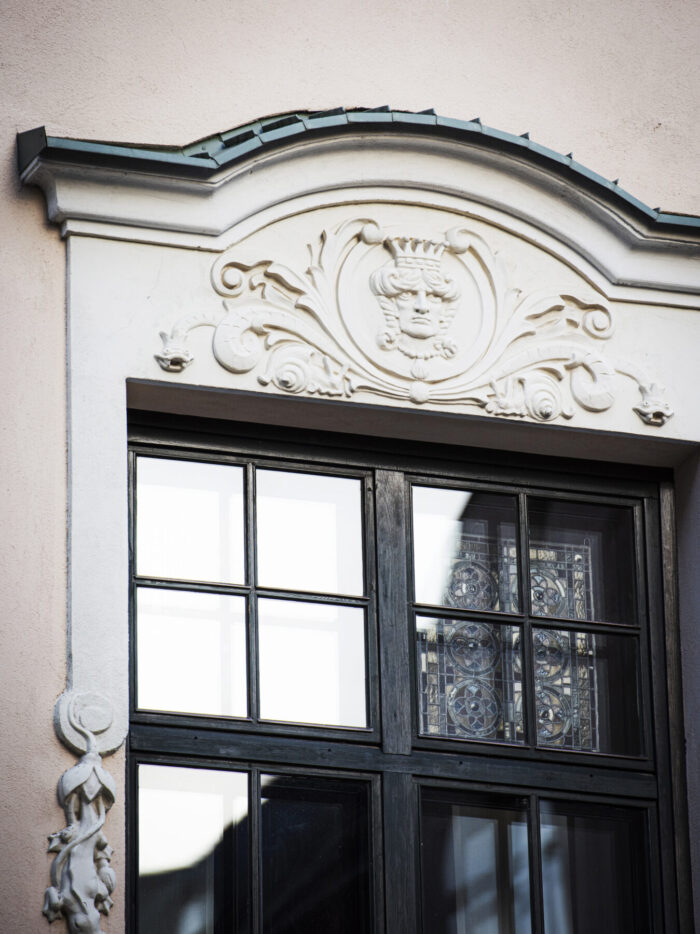
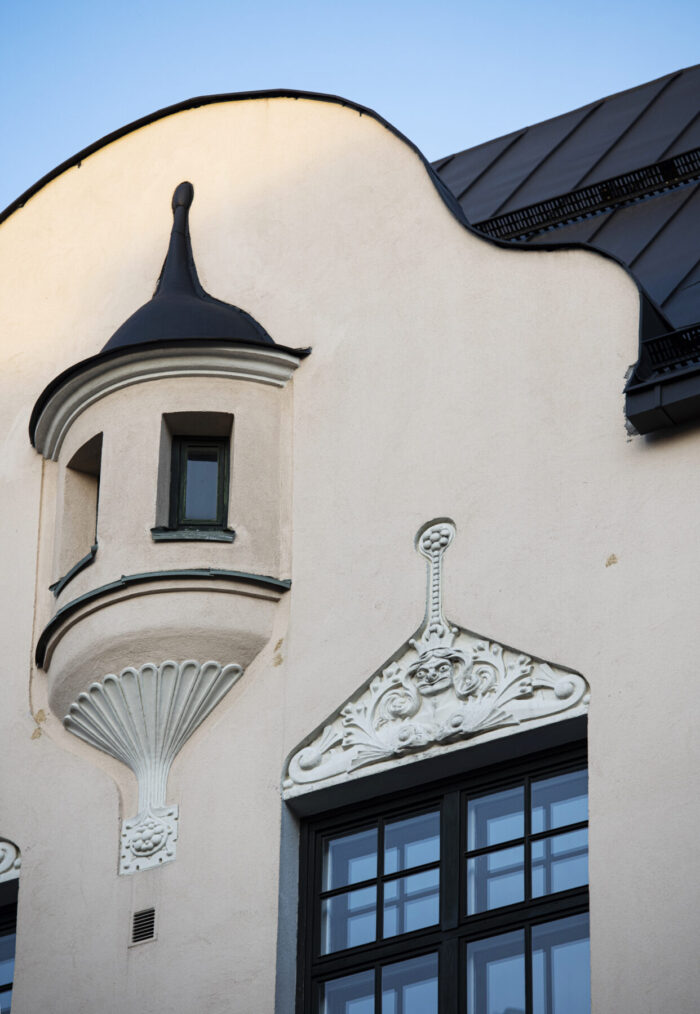
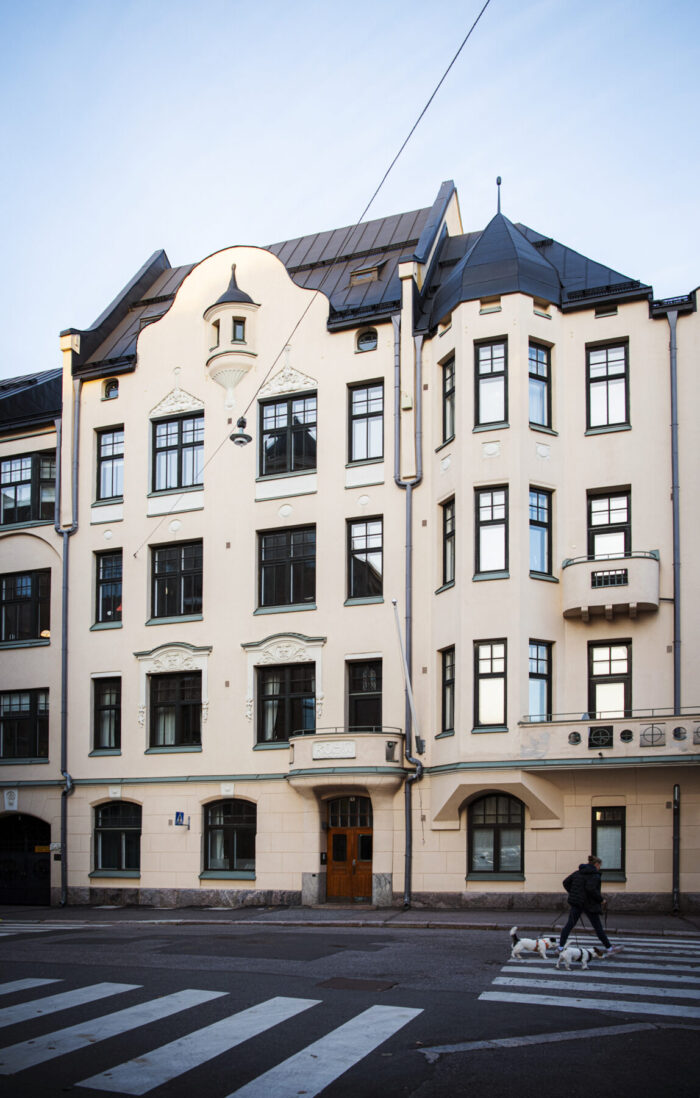
This building pays tribute to its namesake, Vellamo, the goddess of water in Finnish mythology. Flanking one entrance are a pair of sculpted creatures that may at first resemble sea dragons, but their features suggest another inspiration – dolphins, depicted in the classical Roman style. With bulbous heads and pig-like snouts, these dolphins reflect a long-standing tradition carried forward by Western European artists, who – rather than relying on firsthand knowledge of real dolphins – were consciously adhering to classical models in order to evoke the dolphin’s mythological significance.
The sinuous forms, however, are far from serene: sharp teeth and long, curling tongues transform them from playful sea creatures into unsettling guardians of the watery realm. The fearsome presence of these dolphins, poised to strike, adds an unexpected intensity to the building’s design. If you let your eyes wander up the rest of the façade, you will find other faces, some more human than others.
Religious and symbolic figures
St John’s Church, Korkeavuorenkatu 12, Ullanlinna
A.E. Melander, 1891
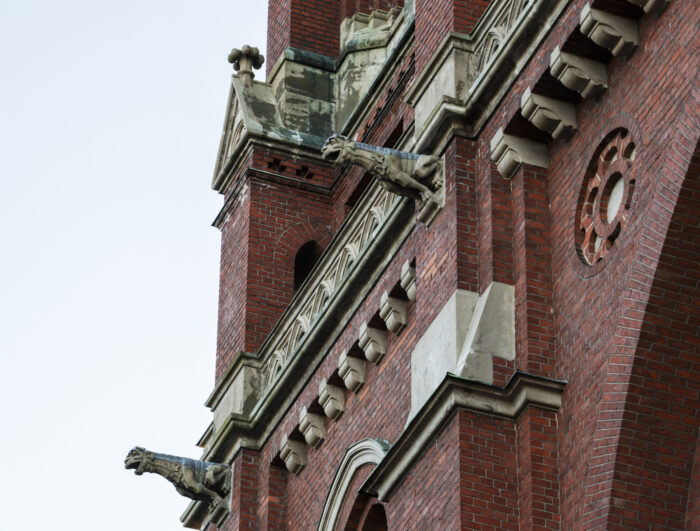
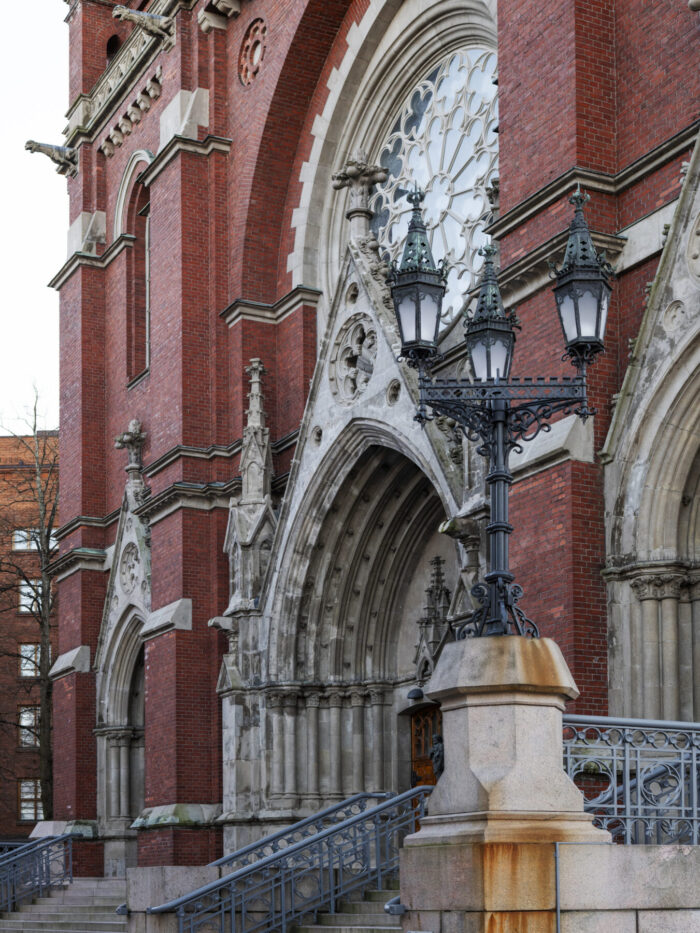
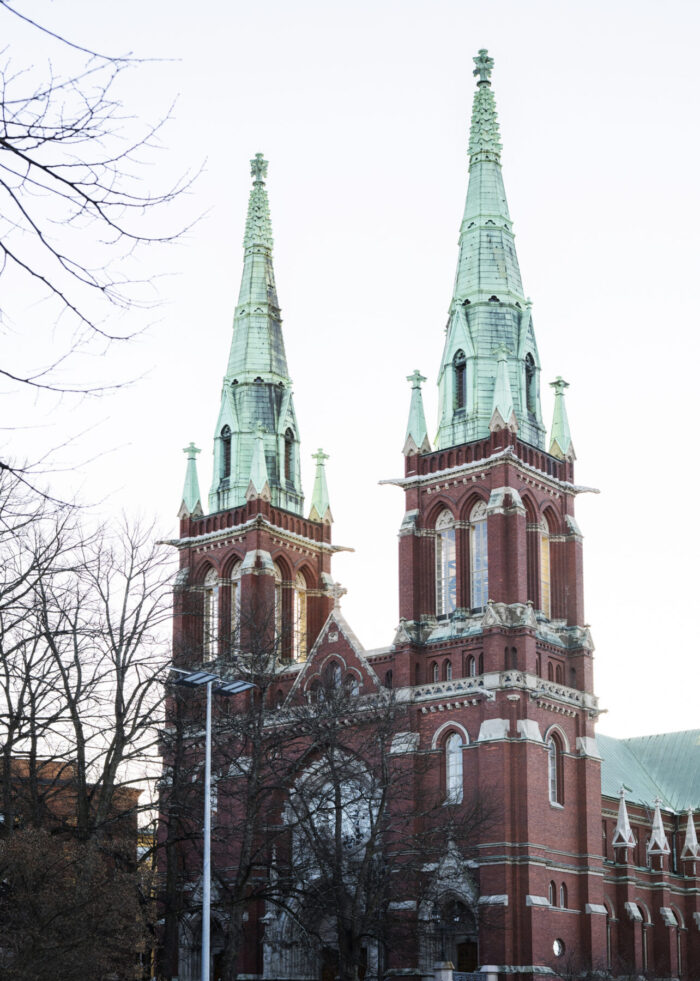
While traditional gargoyles were designed to channel rainwater away from stone walls, the gargoyles adorning this neogothic church do not serve that original function. Instead, they take the form of grotesques – chimeric statues that emphasise the dramatic flair typical of gothic architecture. The spiritual reasons for placing such monstrous figures on church façades in the Middle Ages remain unclear. They may have been intended to ward off evil spirits, intimidate the laity or reflect a medieval Christian worldview, in which even the most grotesque creatures were considered part of divine creation, just as capable as beautiful ones of worshipping God.
Helsinki Cathedral, Senate Square, Kruununhaka
Carl Ludvig Engel, 1830–1852
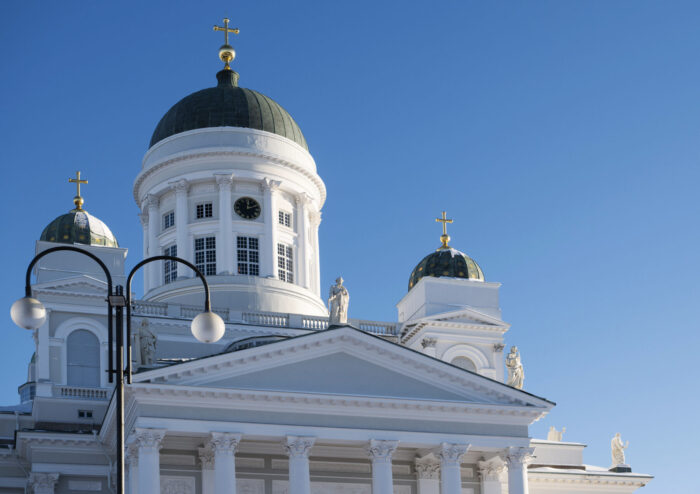
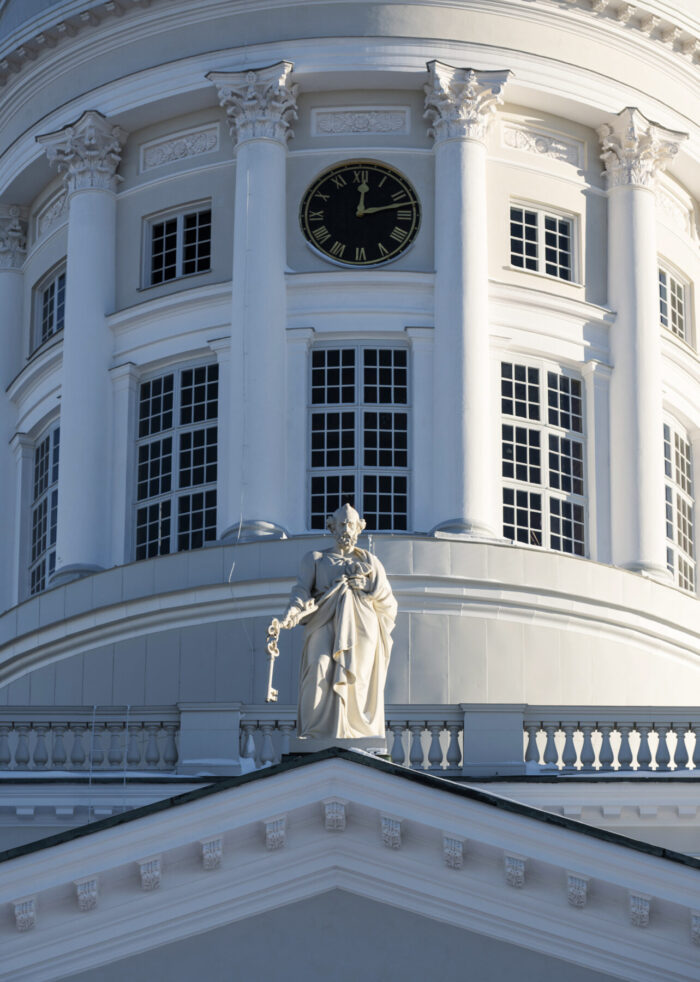
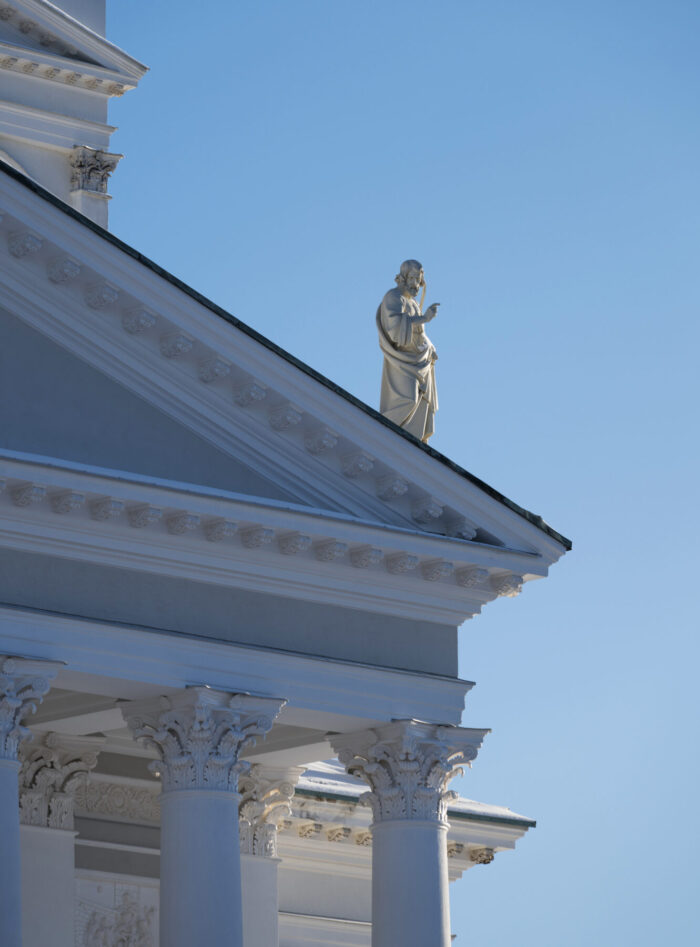
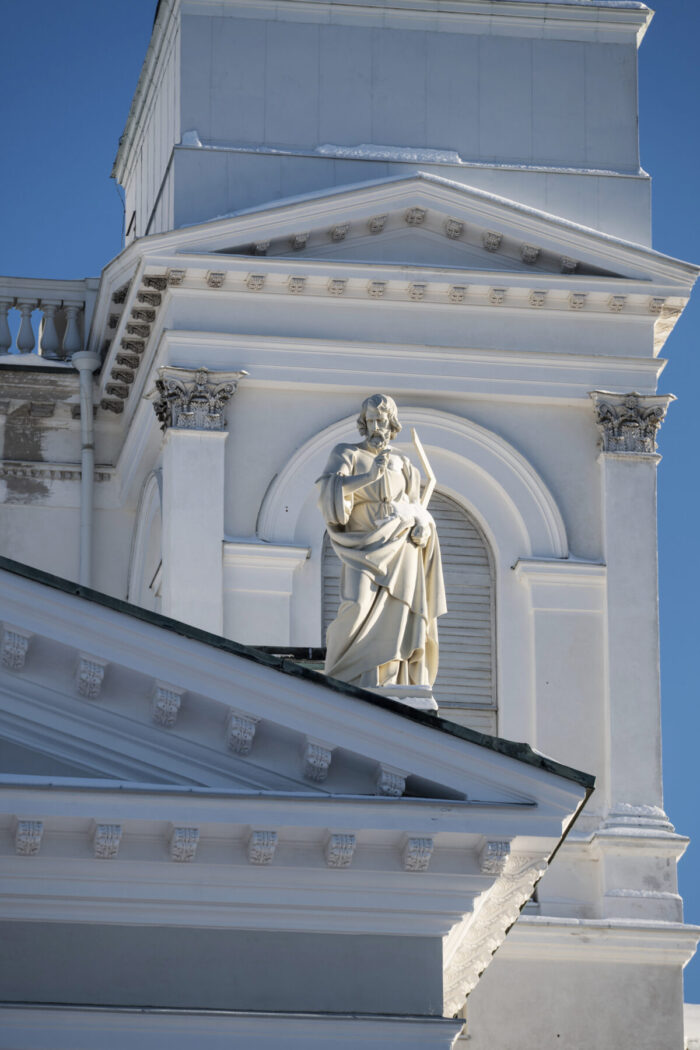
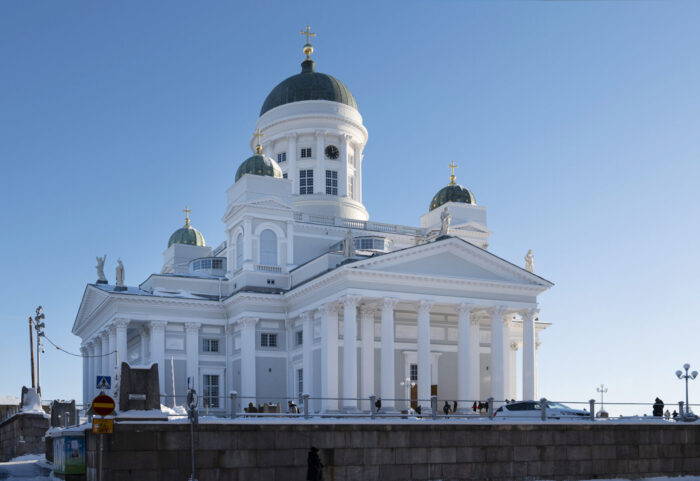
Crowning the city’s most iconic landmark, statues of the twelve apostles stand atop Helsinki Cathedral, their symbolic attributes helping to identify them – a tradition rooted in early Christian art. Peter is shown with the keys to Heaven, Paul with a sword, John a chalice, Matthew an angel, and so on for every apostle, each with something reflecting their biblical roles. This system of visual storytelling became essential in church iconography, allowing worshippers to recognise the apostles at a glance, even in an era of widespread illiteracy.
The animal world
Kontio, Kauppiaankatu 1–3, Katajanokka
Waldemar Wilenius, 1898
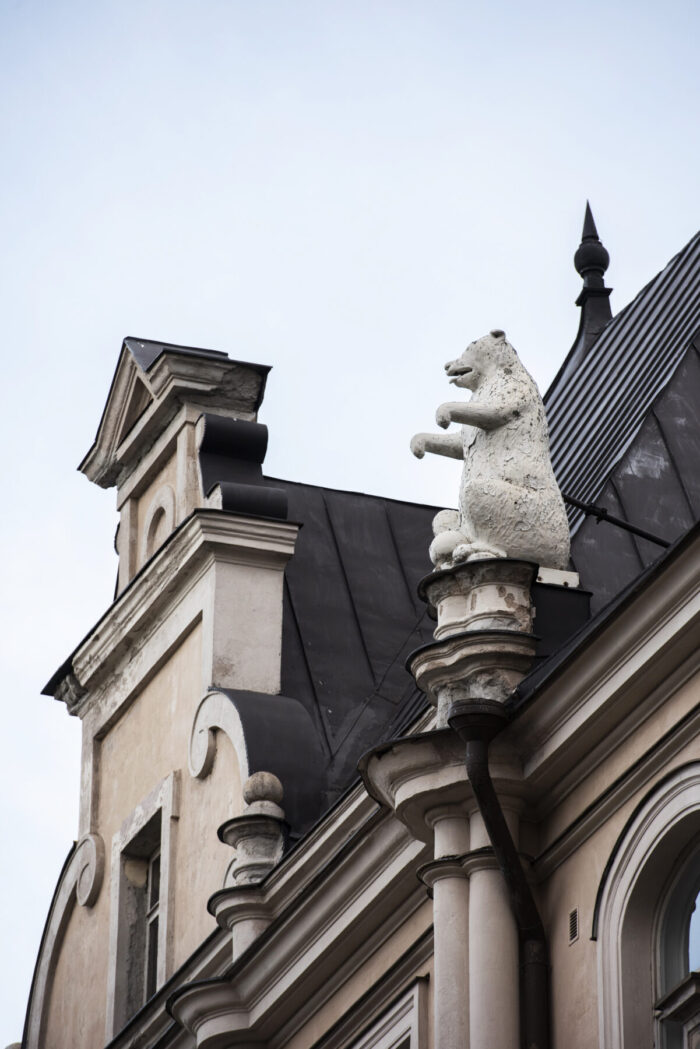
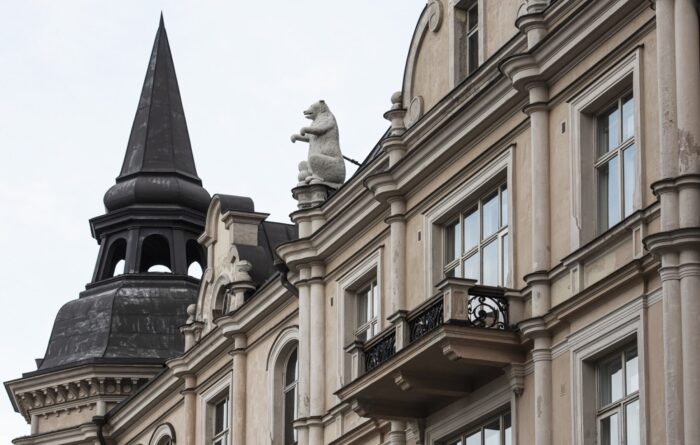
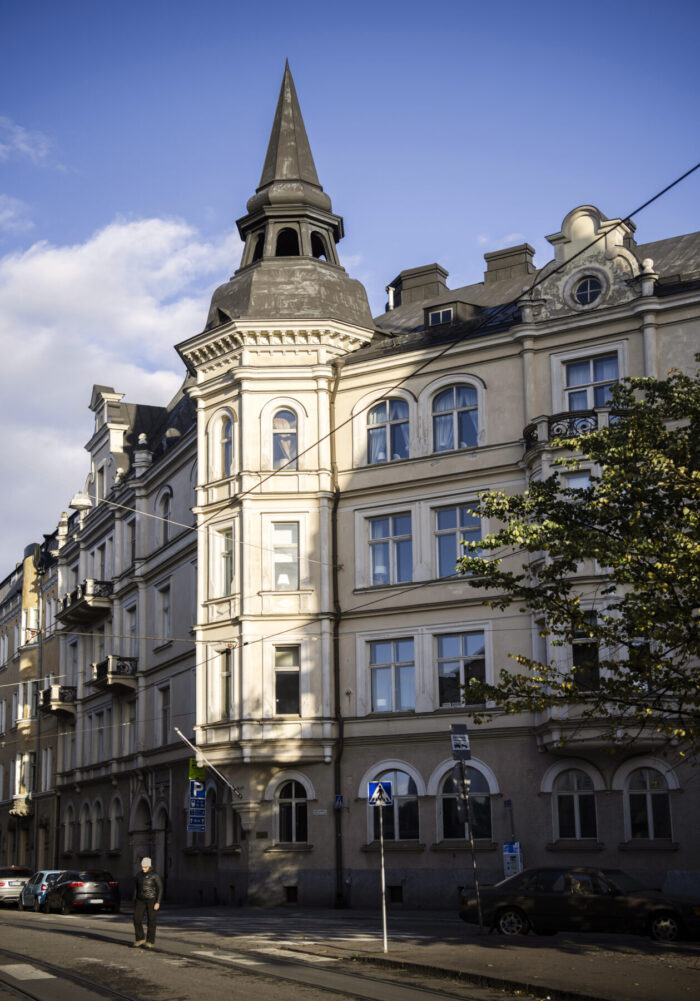
A pair of bear statues stands high above the streets, watching over the intersection. In Finnish folklore, the bear is a revered creature, often seen as a guardian of the forest and a symbol of strength, wisdom and resilience. The building’s name, Kontio, is a synonym of karhu (“bear”).
Traditionally, a successful bear hunt was followed by karhunpeijaiset, a ritual feast honouring the animal and marking its passing. However, by the early 20th century, overhunting had driven Finland’s bear population to the brink of extinction. Conservation efforts and legal protections have since allowed the species to recover, and today, Finland is home to over 2,000 bears – an enduring presence in both the wilderness and the cultural imagination.
Kruunuvuorenkatu 3, Katajanokka
Georg Wasastjerna, 1902
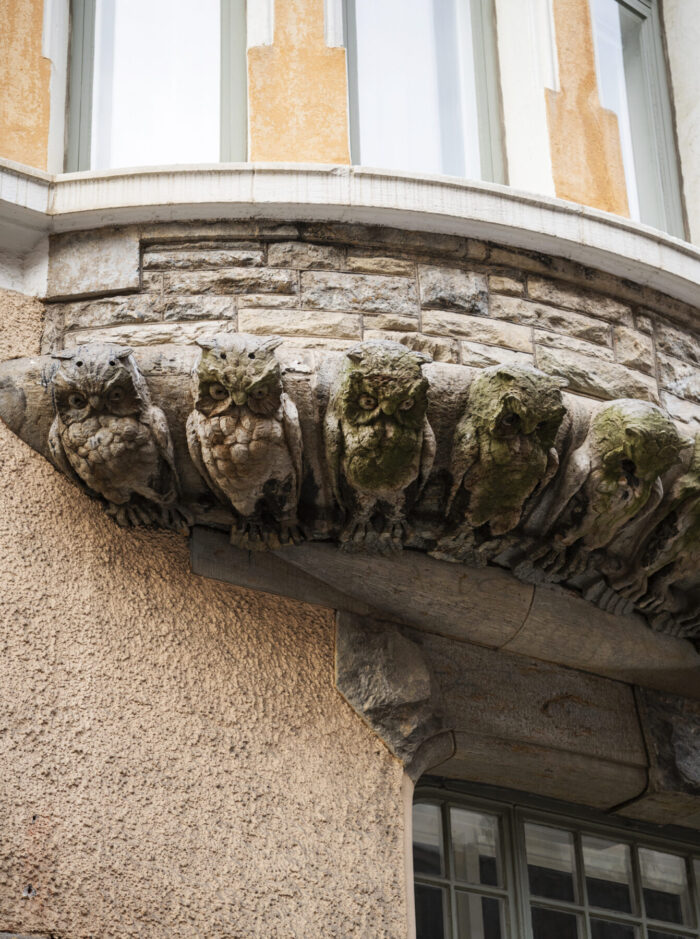
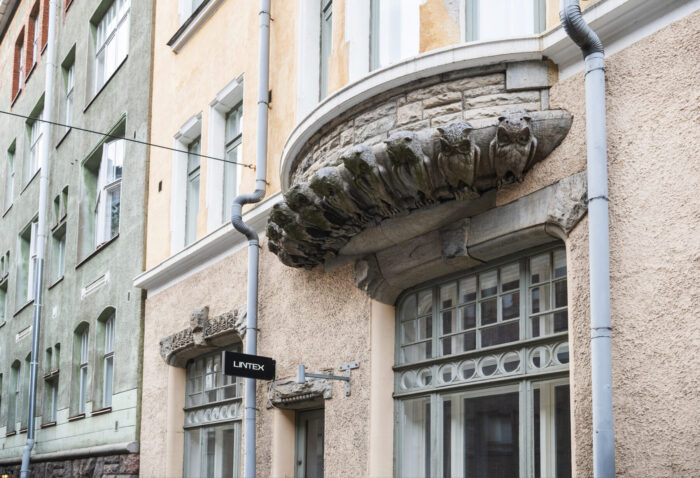
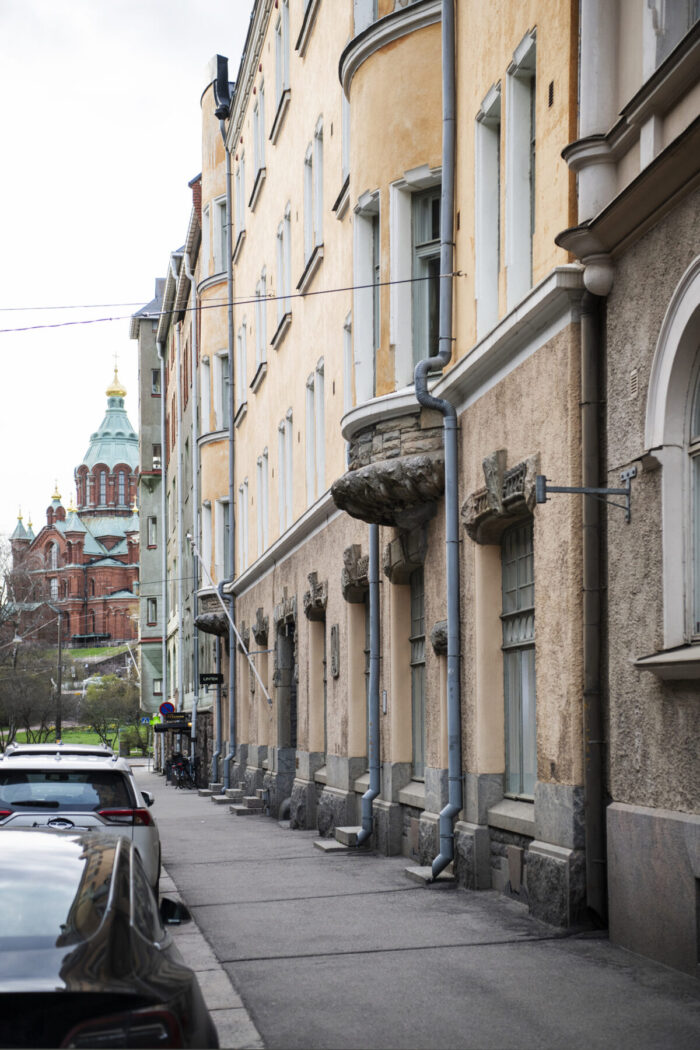
Below each set of bay windows on this art nouveau building, a row of sculpted owls watches over the entrance, their sharp eyes gazing at passers-by from furrowed brows. Despite their association with wisdom, the Finnish word pöllö (“owl”) can also refer to a fool.
Ten owl species breed in Finland, including the majestic eagle-owl, Europe’s largest, which was nearly driven to extinction by hunting – until the 1950s, people were even paid rewards for killing them. Today, the eagle-owl is a protected species, and conservation efforts continue.
Finland’s men’s football team goes by the nickname Huuhkajat (Eagle-Owls), while the women’s team is called Helmarit (Boreal Owls).
Mariankatu 11, Kruununhaka
A.H. Dalström, 1877
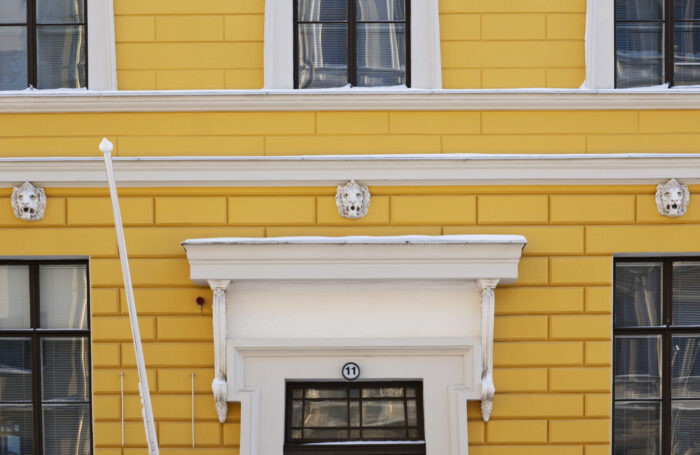
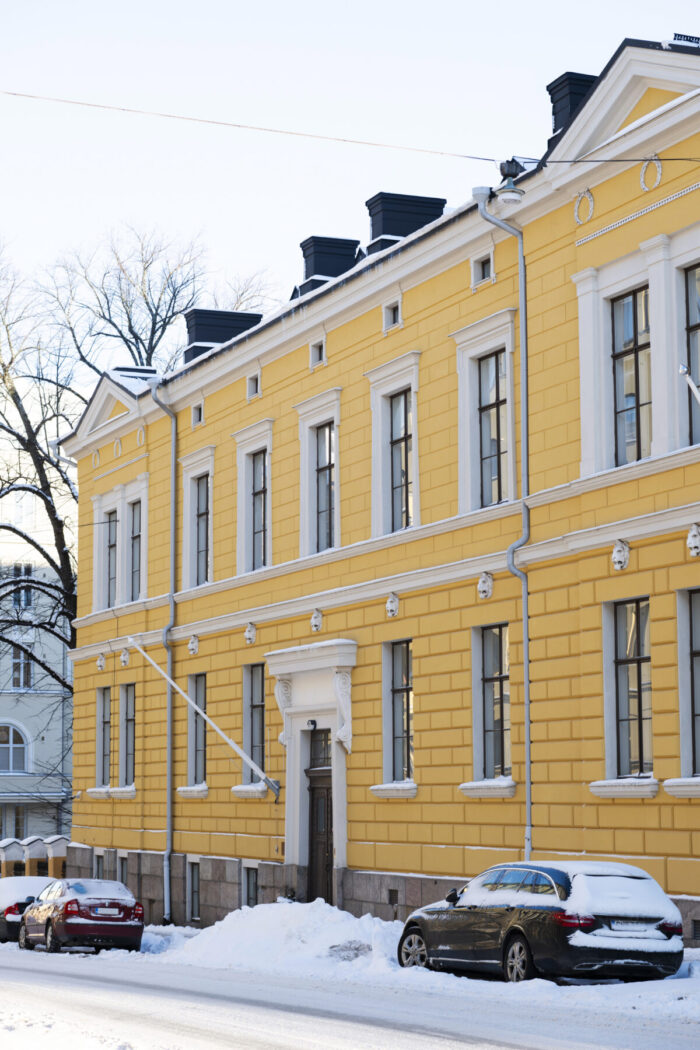
This historic building and former middle school features sculpted lion faces above its entrance. Their fierce expressions lend a regal quality to the façade, though they are easy to miss if you don’t look up.
Symbolic guardians
National Archives, Rauhankatu 17, Kruununhaka
Gustaf Nyström, 1890
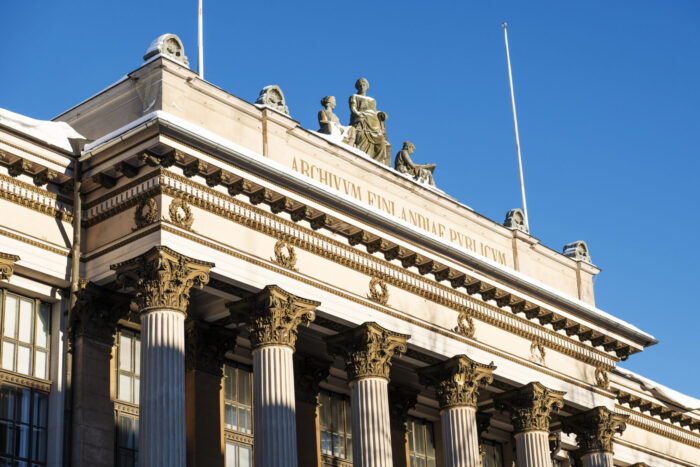
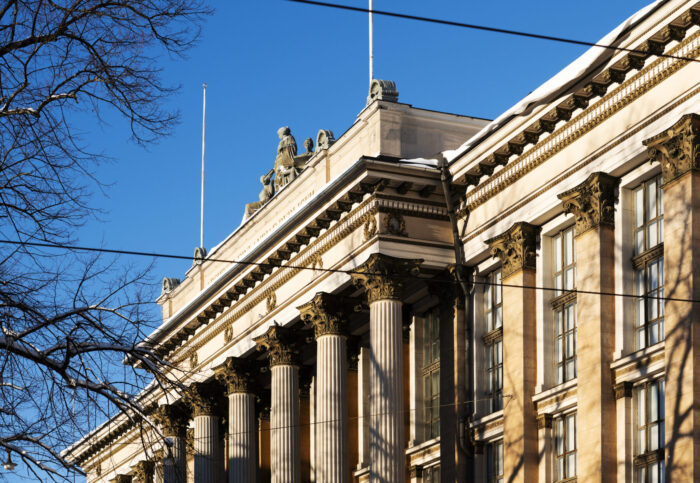
Above the entrance stands a trio of statues known as the Three Geni, completed in 1889. In Roman mythology, genius referred to a deity or guardian spirit, making these figures a fitting choice for the National Archives. The central figure represents Finland itself, while the two flanking statues symbolise historical research and writing – reinforcing the building’s role in preserving the nation’s past.
Rauhankatu 4 and Meritullinkatu 10, Kruununhaka
Georg Wasastjerna, approximately 1915
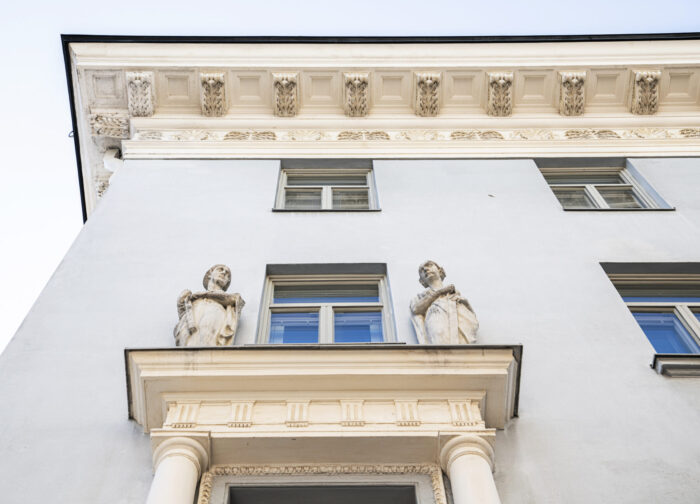
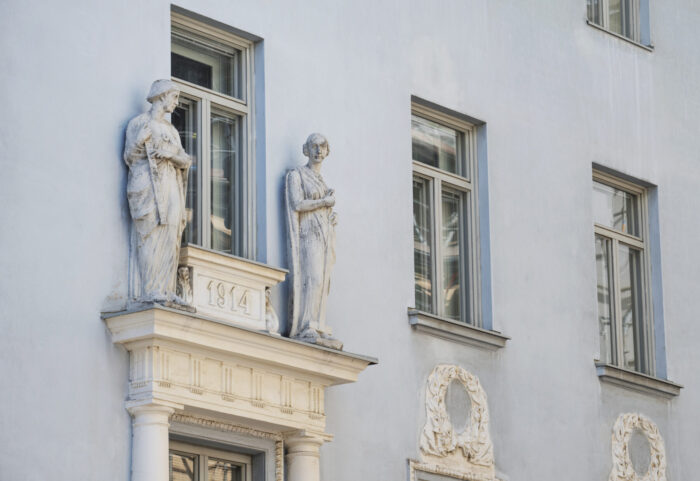
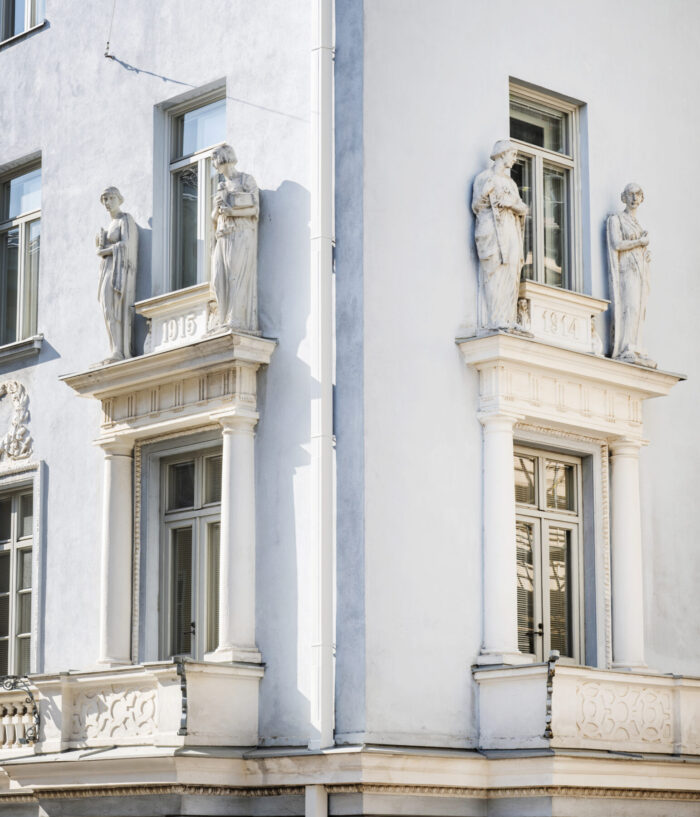
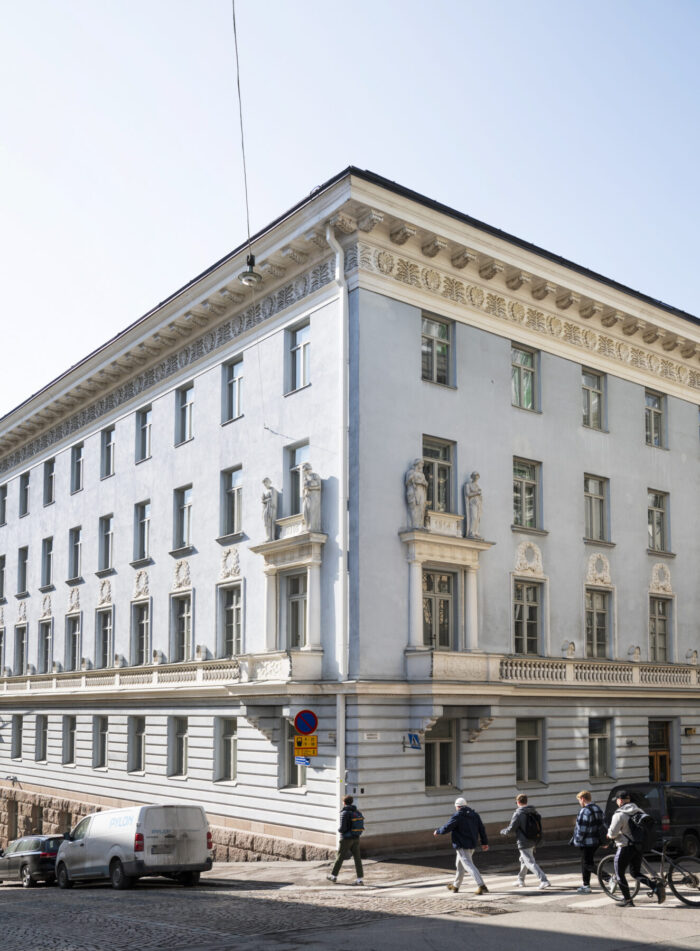
Above the second floor of this historic building, eight statues serve as symbolic reminders of its original function as the headquarters of the National Land Survey. Although it later came to house the Ministry of Education and Culture, the statues continue to evoke the technical expertise and heritage of land surveying.
Each figure holds an item that represents key aspects of that work: a gear and triangle; a model of a building; a ruler; and a T-square. These objects highlight the precision and creativity required in the fields of surveying, architecture and urban planning, reflecting the building’s role in shaping Finland’s infrastructure.
Other honourable mentions
Pohjoisranta 4, Kruununhaka
Theodor Höijer, 1885
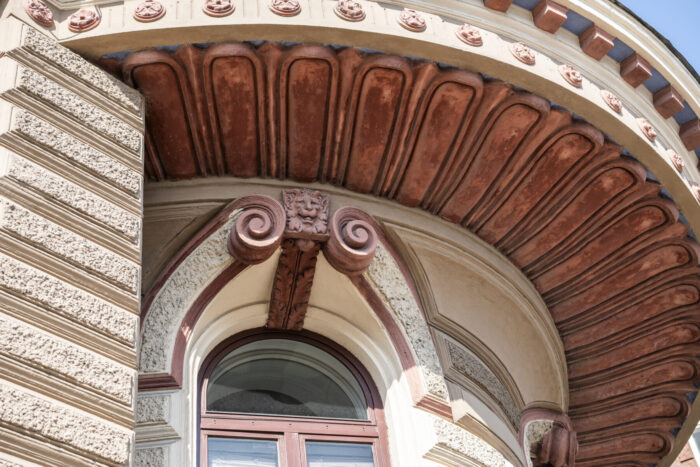
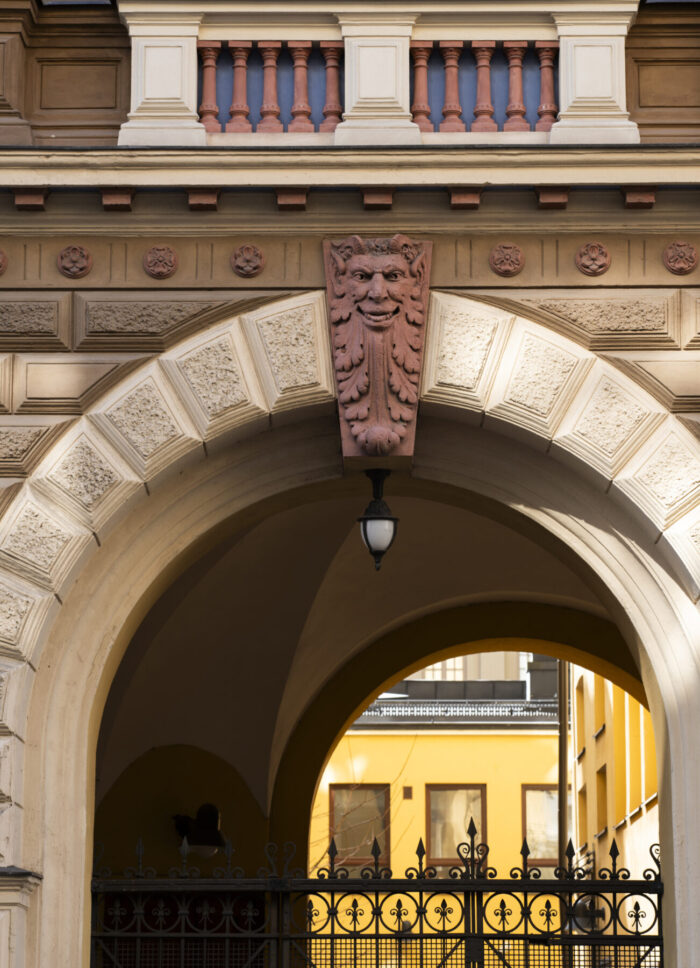
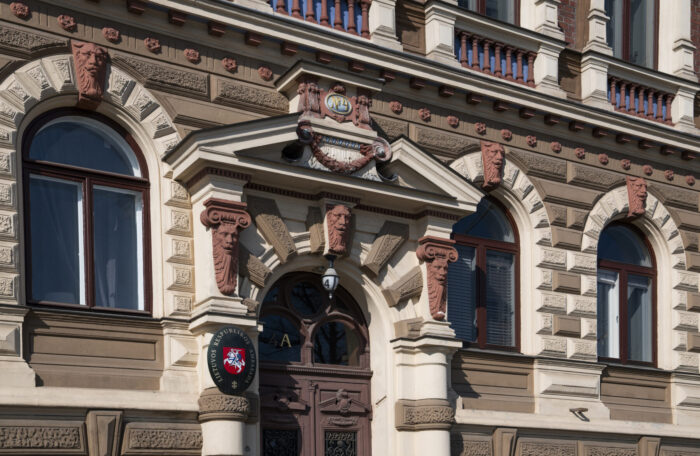
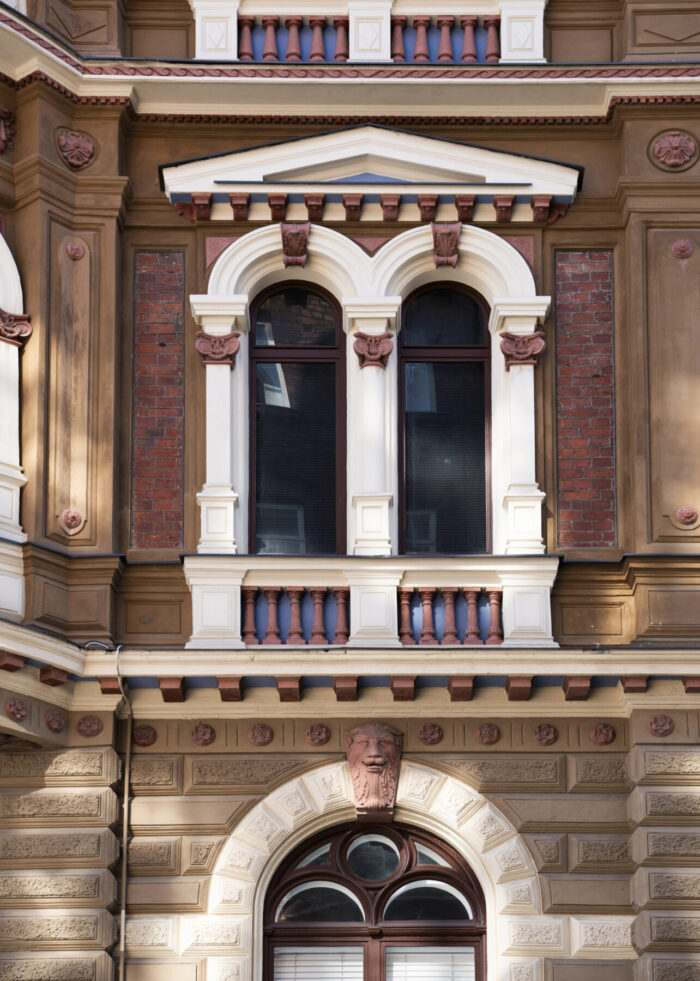
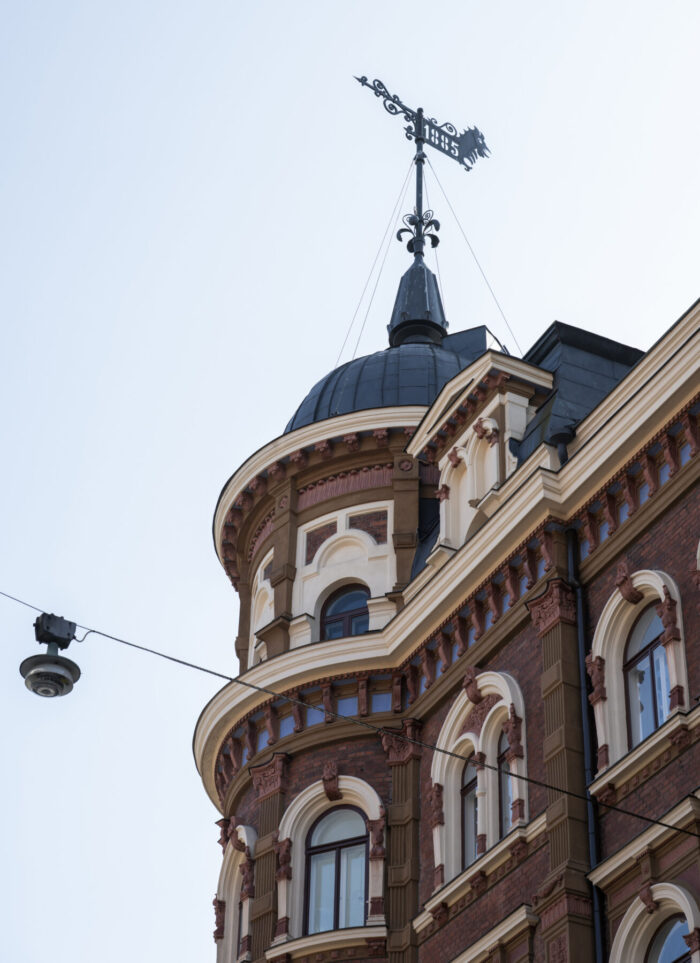
Above each window, keystone sculptures of fauns – half-human, half-goat creatures from Greek and Roman mythology – adorn this 19th-century renaissance revival building. The figures, emblematic of the period’s fascination with antiquity, add a layer of mystery to the façade, evoking both mischief and wisdom.
Lundqvist Building, Aleksanterinkatu 13, Kluuvi
Selim A. Lindqvist, 1900
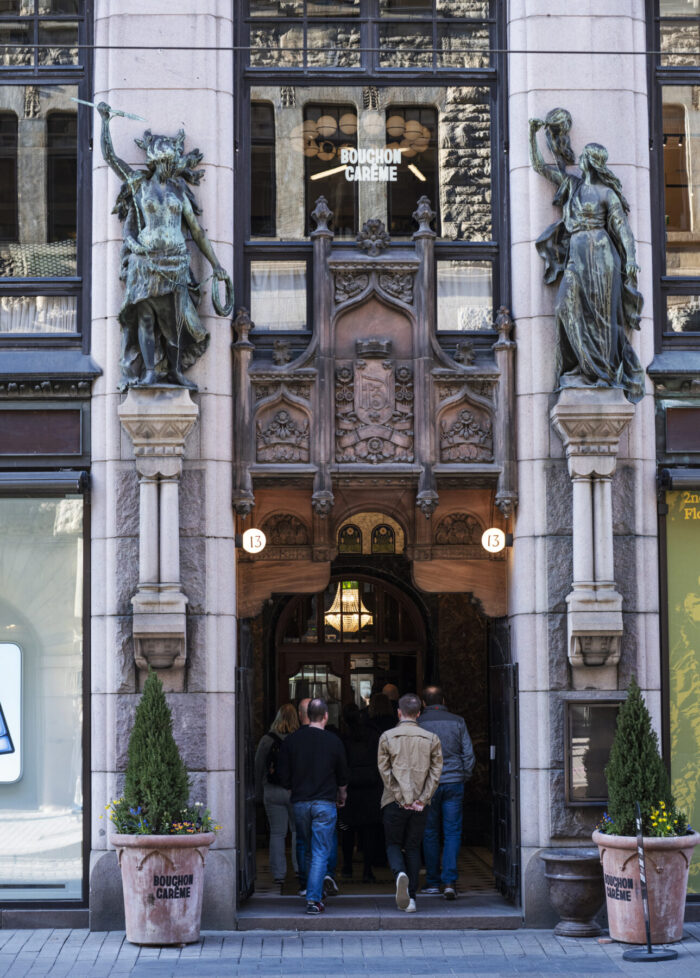
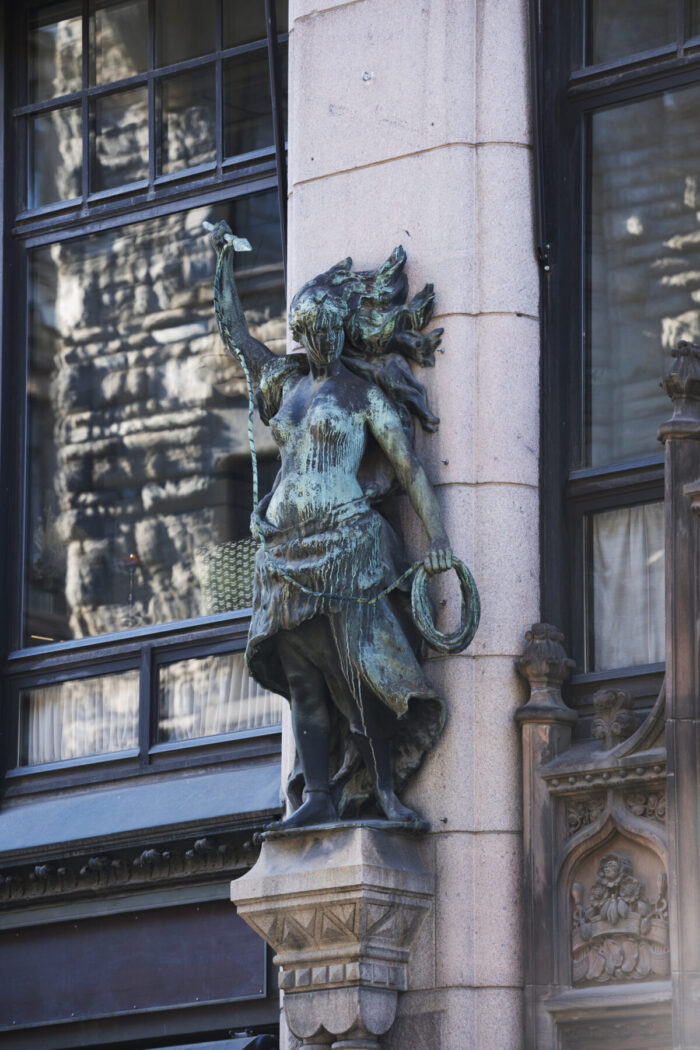
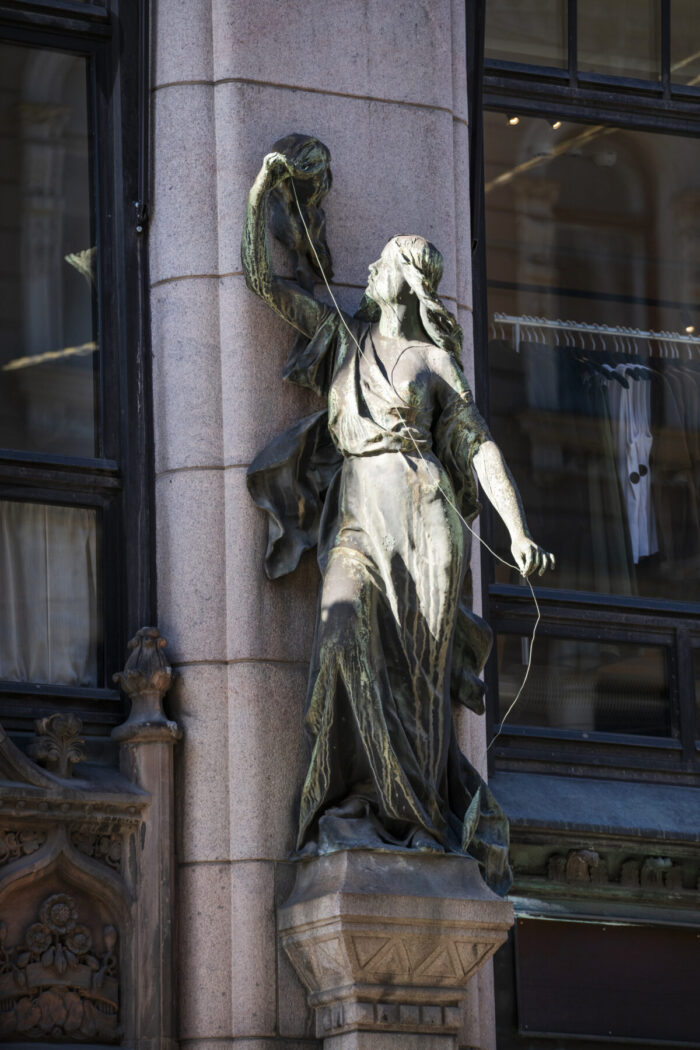
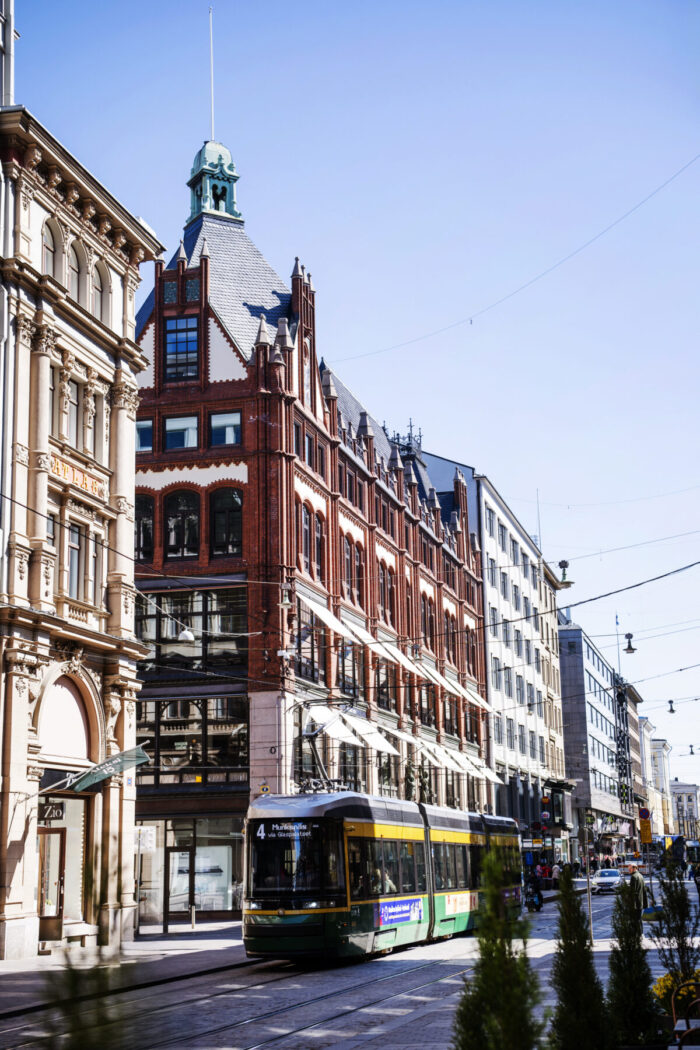
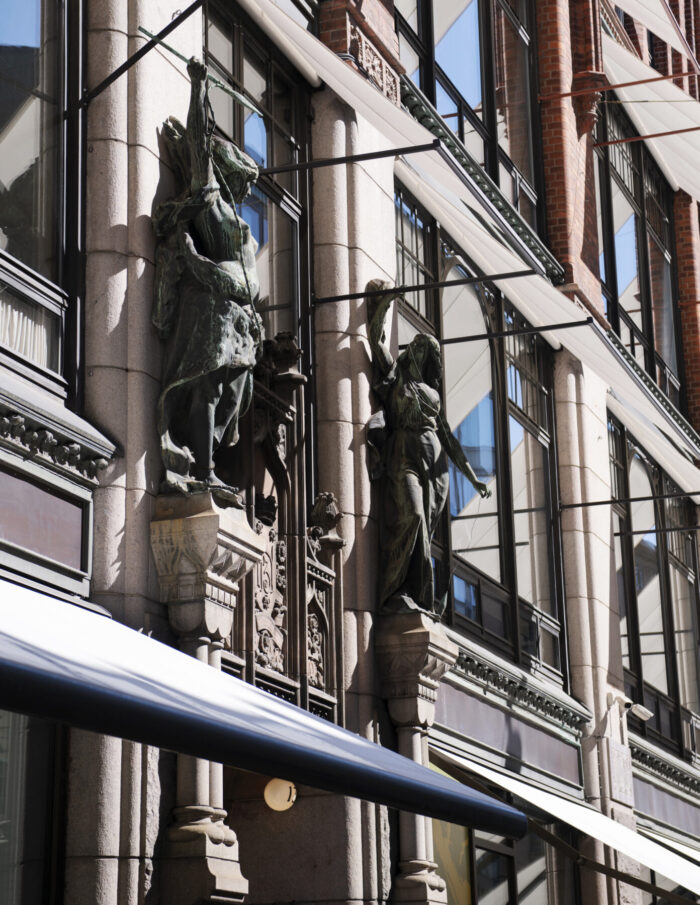
Helsinki’s first purpose-built commercial building features two prominent sculptures by Robert Stigell: Spinning and Hunting. One statue depicts a woman holding a ball of wool, symbolising craftsmanship and industry, while the other shows a figure with a spear and rope, evoking themes of hunting and livelihood.
Both statues draw inspiration from mythological goddesses such as Artemis, protector of hunters, and Athena, goddess of crafts, wisdom and practical skills. These sculptures reflect the building’s original purpose as a hub for commerce, embodying the spirit of industry at the heart of Helsinki’s development.
Helsinki’s sculpted figures offer a glimpse into the city’s rich history and mythology. Whether guarding buildings or simply observing from above, these sculptures – rooted in Finnish folklore and history – are more than just decoration. As you explore the city, take a moment to look up and discover the silent guardians that connect Helsinki to its cultural and natural heritage.
By Tyler Walton, October 2025; photos by Kirsi-Marja Savola
